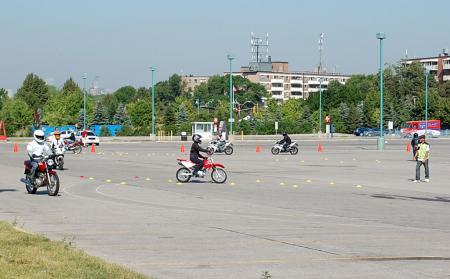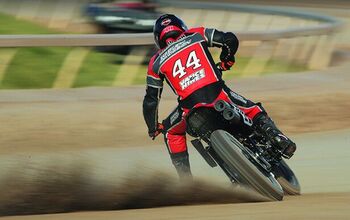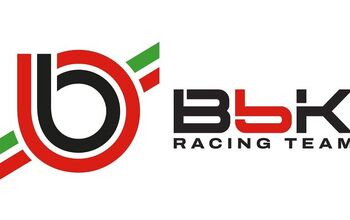Motorcycle Beginner - Year 2: Motorcycle Ownership
What a difference a year makes.
Last summer we ran our Motorcycle Beginner series to illustrate the process of how to get started as a rider. With yours truly as the test subject, we went shopping for riding gear, passed (eventually!) a qualified rider training program, examined the process of selecting a first motorcycle and provided a newbie’s perspective of Honda’s entry-level CBR250R.
One year later, I’ve moved out of the suburbs, bought a condo in the city, met my incredible girlfriend Jackie and purchased my first motorcycle. It’s been quite an eventful year, and riding has been a big part of that. I rode my bike to my first date with Jackie and one of our early dates was a trip to the Toronto Motorcycle Show. Motorcycling has become a vital part of my life.
And now, with more than 3000 miles of riding under my belt, do I still consider myself a beginner? Of course I do. There’s always more to learn about riding, no matter how many clicks you log on the odometer.
Last year’s Motorcycle Beginner series was about how to get started in motorcycling. This year, we’ll look at the next step, being a motorcycle owner, being part of the larger motorcycling community, how to grow as a motorcyclist, and moving on to larger bikes.
Buying My First Bike
Shortly after returning the CBR250R to Honda, I started the search for my own bike. Those who read the Motorcycle Beginner series last year will remember I like to take a very practical approach to things. I started by writing down a list of the qualities I wanted in a motorcycle.
Everyone’s wish list will be different, but my list included the following:
- Mid-sized engine displacement and performance: Few people actually need superbike-sized power, and I am not one of them. For everyday commuting and the occasional freeway trip, a mid-sized bike with moderate power will do nicely. Where I live, there’s also a significant jump in insurance rates when you go larger than 600cc.
- Neutral, upright ergonomics: I want a bike I can ride comfortably for long segments. I may want to tuck down a bit at highway speeds but tight sportbike ergos aren’t for me. On the other hand, a laid-back cruiser posture with forward-mounted foot controls isn’t my cup of tea either.
- Costs: I was saving up for a down payment on a condo and the ensuing mortgage payments, so obviously the purchase price of a motorcycle was a big concern. Beyond the bike's sale price, there's also the added cost of insurance, as well as maintenance expenses. I also wanted to have room in my budget for …
- Accessories: A stock motorcycle provides a good base, but to really own a motorcycle means being able to customize it to suit your needs. I wanted a model with strong aftermarket support so I can set it up the way I want.
Ideally, I would find a bike that meets every item on my check list, but realistically, I expected a bit of give and take, especially if I wanted to stay within my budget.
We touched upon the topic of selecting a first motorcycle in last year’s Beginners series, and Associate Editor Troy Siahaan re-visited the topic as part of our new Safety Series running through July. This provided plenty of food for thought as I started out my search.
The first decision I had to make was whether to buy a brand new motorcycle or an older, pre-owned bike. New motorcycles offer the latest updates and technologies, are supported by warranties, and have a clean history with minimal mileage and no previous accidents or damage. The trade-off however is a much higher purchase price compared to an older used model. Pre-owned motorcycles are much more affordable and can be cheaper to insure. They may cost more to maintain however, and they carry the scars of many miles of use, not to mention the odd mishap.
I decided to go the pre-owned route, mainly because it better fit my limited budget. I picture myself riding this bike for a couple of seasons before moving up to a more advanced model. Motorcycles depreciate fairly quickly once they leave the showroom floor, and it did not make sense to invest a lot of money in a new motorcycle at this point in my life.
After a week of browsing through dealership websites and online classified listings, I found a listing for a 1989 Suzuki GS500E. The 487cc standard is a popular choice as a first motorcycle. The E was the naked version, later replaced in the U.S. market by the faired GS500F, but the GS had remained relatively unchanged since its introduction in 1989. This particular GS was white with blue stripes and came with clip-on handlebars, both unique to that initial model year.
Suzuki claims the engine produces about 52 hp and 30.4 ft-lb. at the crank, good enough for my needs, though the engine was carbureted and not fuel-injected as I’d hoped to have on my bike. The seating position is fairly upright, though the clip-ons necessitated a slight forward lean. It was a little older than I was hoping for, but the mileage was relatively low for its age.
When I met the seller, he told me the GS500E was his first bike. He said he was looking to move up to a Kawasaki Versys. He only had the GS for a bit more than a year, but he kept it maintained with new spark plugs, petcock, fuel lines and a K&N carb kit. What sealed the deal for me was the owner threw in a number of accessories and add-ons, including a bike cover, a small windshield, engine guards, tank bag, saddlebags and a Haynes repair manual, all for a total price of $2000 (Canadian).
That was a far better price than a lot of other listings I was considering, and the add-ons made it a much better value. A couple of nights to think it over and a handshake later, I became the proud owner of a 1989 Suzuki GS500E.
Transitioning to the Bigger Bike
The transition from the Honda CBR250R to the Suzuki GS500E was pretty smooth. The GS’s seat is about a half-inch higher while the CBR has a more vertical seating position, but otherwise the ergonomics felt similar enough. At around 412 pounds wet, the GS500E weighs about 50 pounds more, a noticeable difference when pushing it around, but it still feels as light and nimble in motion.
The big difference is the engine with the GS500E’s power and torque much larger than the CBR250R’s numbers (22.6 hp and 15.1 ft-lb. as dyno tested for our 2011 250cc Beginner Bike Shootout) but that’s no surprise given the larger engine. Accelerating to highway speeds comes much easier on the GS than the CBR, but the newer Honda was not surprisingly smoother when shifting gears.
As expected, the carbureted GS500E needs a bit of choke in the morning, especially when compared to the quick start and go with the fuel injected CBR250R. The throttle response is also not as smooth as on the CBR, even with the K&N jet kit.
Another hiccup is the lack of a fuel gauge, a feature I really missed from the CBR250R. In my review of the Honda, I noted the sensors needed a few minutes to provide an accurate reading of the fuel level, but it was still much better than not having a fuel gauge at all. More experienced riders will be familiar with knowing when to refuel, but new riders will feel more comfortable knowing just how much they have left in the tank.
Electric vehicle owners are familiar with the term “range anxiety”, the fear of running out of juice before they can get somewhere they can plug in and recharge. Riding without a fuel gauge gives a similar feeling. The first few times between fuel-ups were especially nerve-wracking as I was still adjusting to the new bike and my fuel economy varied quite a bit.
I was visiting my cousins one morning when I first reached the bottom of my main fuel setting and had to switch to reserve. Just after cresting a steep hill, I noticed my revs started decreasing and throttle response became sluggish. I waited for a safe place to pull over and actually coasted to a stop as the engine cut out. I switched the petcock from “ON” to “RES” and waited a bit for the fuel to start flowing again before I restarted the engine and went searching for a gas station. Thankfully traffic was light and there was enough fuel for me to reach the top of the hill, but I learned that morning the importance of watching the trip meter and learning how to reach the petcock while in motion.
I bought the GS500E in mid-September 2011 and I managed to squeeze in a month and a half of riding before deciding to put it into storage for the winter. Some owners may want to take care of winter storage themselves, draining carbs, adding fuel stabilizer, minding the fluids and putting the battery on a trickle charger. I opted to pay a dealership to store the GS for the winter and take care of the maintenance.
A New Year, A New Riding Season, A New Life
I picked up my motorcycle four months later, though it seemed longer than that, and that’s not just because of the crowded subway train that again became my daily commuter. Over the winter, I purchased a new condo on the east side of Toronto. And with this move came changes to my riding habits.
Underground parking spaces can also be rather cramped, but I was again fortunate to have space to park both my vehicles. One problem I did encounter was the amount of dust accumulating in the garage. My building is old and the garage air vents are not particularly great, resulting in a lot of dust. The problem was made worse by garage renovations over the spring which only thickened the layer of dust that settled on every surface. Fortunately the former owner of my GS500 included a bike cover which offered protection from the grime.
My commute to work is now much shorter than before. Instead of a 20-mile journey with most of it on a traffic-snarled freeway, my commute is a much more pleasant nine-mile jog along the shores of Lake Ontario. Riding alongside the beautiful beaches of Toronto’s Ashbridge’s Bay is a much better experience than being stuck in bumper-to-fender traffic on the Don Valley Parkway.
Yes, life is good. At least, it was until that car hit me. Read more about that in the second part of this series.
Related Reading
Motorcycle Beginner - Year 2: The First Accident
Motorcycle Beginner - Year 2: Buying Your Next Bike
Motorcycle Beginner - Year 2: Canadian Superbikes at Mosport
Motorcycle Beginner: I Want to Ride
Motorcycle Beginner: Buying Riding Gear
Motorcycle Beginner: Rider Training
Motorcycle Beginner Diary: What I Love About Being a Motorcyclist
Motorcycle Beginner: 2011 Honda CBR250R Newbie Review
Three for Five: Budget Bombers
Suzuki GS500 Front Brake Upgrade
More by Dennis Chung




































Comments
Join the conversation